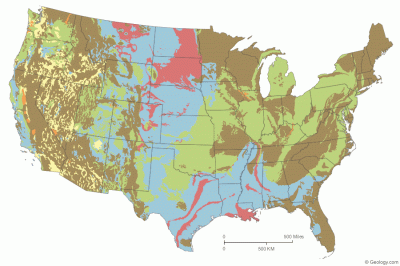- Homepage
- >
- Research/Projects
- >
- A thermodynamic approach to chemical soil stabilization
A thermodynamic approach to chemical soil stabilization
A Bottom-up Approach to Design of Chemical Soil Stabilization Using Thermodynamic Modeling
NSF Award #1740554 Division of Civil, Mechanical and Manufacturing Innovation, Geotechnical Engineering and Materials Program
Project Information and Abstract
Clay soils are present in large parts of the United States, such as Texas, Oklahoma, Kansas and others (red and blue on this map from https://geology.com/articles/soil/).

Since clay soils are unsuitable as foundations for construction of highways and other structures, various stabilization techniques are employed to improve their properties. Chemical soil stabilization using lime and Portland cement is among the most widely applied approaches. We also use this approach to treat in situ soils contaminated with a variety of contaminants, such as heavy metals, PCBs and nuclear waste.
What don't we know about this process?
- We can't predict in advance the dosage we want.
- We don't know how the material will behave 1,2 or 10 years after it is placed, nor how it will respond to climate change induced parameters such as increased precipitation or acidification.
What can we do about it?
- We can create models.
What kind of models?
- Thermodynamic and kinetic models that will predict the soil-cement composition over time.
- Coupled mechanical-chemical models that relate the chemistry changes to evolution in mechanical properties such as strength.
This project is focusing on step #1 and aims to generate the fundamental kinetic and thermodynamic models that will quantitatively describe the evolution of the chemical reactions between clay minerals and common stabilizers (lime, Portland cement).
How do we develop the models?
- We create controlled systems in the lab, i.e. use pure clay minerals and stabilizers and recreate the in situ mixing conditions.
- We study the pore solution composition as a function of time with typical analytical techniques.
- We study the solid composition as a function of time with state-of-the-art techniques including X-ray Diffraction (XRD), thermogravimetric analysis (TGA) and Nuclear Magnetic Resonance (NMR).
- We create a geochemical model and fit the model output to the experimental data (this is harder than it sounds).
Project Overview by Tasneem Ahmadullah
Project Publications
Ahmadullah T. and Chrysochoou M. 2022. Strength Development and Reaction Kinetics in Lime-Treated Clays, Geo-Congress 2022, https://doi.org/10.1061/9780784484012.014
Ahmadullah T. and Chrysochoou M. 2023. Relationship between Strength Development and Pozzolanic Reactions in Lime Stabilized Kaolinite, Engineering Geology, submitted for publication May 27, 2022.
Project Presentations
Ahmadullah T and Chrysochoou M, 2022. Relationship between strength development and pozzolanic reactions in lime stabilized clay. ACS Fall, 2022, Chicago, IL. Ahmadullah ACS Fall 2022 POSTER
Ahmadullah T and Chrysochoou M, 2022. Relationship between Strength Development and Pozzolanic Reactions in Stabilized Kaolinite, 2022 Goldschmidt Conference, Honolulu, HI. Ahmadullah_Goldschmidt_2022
Ahmadullah T and Chrysochoou M, 2022. Geochemical analysis of clay soil stabilization. ACS Spring, 2022, San Diego, CA. Ahmadullah_Poster ACS Spring 2022
Ahmadullah T., Bompoti N. and Chrysochoou M. 2021. Thermodynamic and kinetic modeling of cementitious reactions in lime-treated clays, Goldschmidt 2021 virtual conference, July 4-9 2021. Ahmadullah_Goldschmidt_2021
Ahmadullah T. and Chrysochoou M. 2020. Evaluation of reaction kinetics in chemical clay soil stabilization, 57th Annual Meeting of the Clay Minerals Society, October 18-23, 2020, virtual meeting.
Ahmadullah T., Bompoti N. and Chrysochoou M. 2020. Thermodynamic and kinetic modeling of cementitious reactions in lime-treated clays, Goldschmidt 2021 virtual conference, July 4-9 2021. PDF of presentation Ahmadullah_Goldschmidt_2021
University of Connecticut Frontiers 2021: Undergraduate Research Symposium Caitlin Jenkins Portfolium Presentation